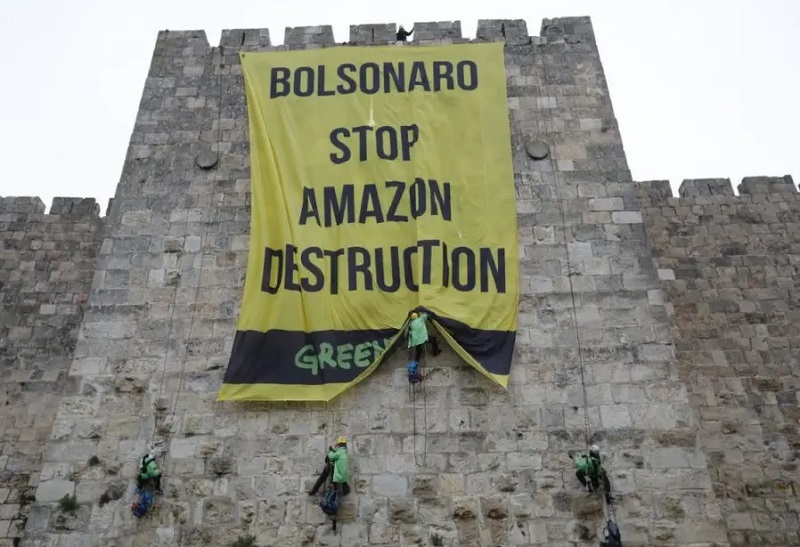Amazon Territory Smoulders as Brazil’s Bolsonaro Denies Devastation
By Monica Raymunt (dpa)

HAVANA TIMES – Before Brazilian President Jair Bolsonaro took to the podium in New York to deny rainforest devastation in the Amazon, dpa saw hundreds of hectares of deforested land and more than a dozen fires on protected indigenous territory in Brazil’s northern state of Para.
A grey haze and the smell of charred wood fill the eight-seater plane as it bucks up and down through the turbulence.
Greenpeace activist Danicley Saraiva de Aguiar stares out one of the windows as the group’s mapping expert Andre Arruda hunches over his laptop, his right hand slicing through the air as he directs the pilots to the first fire.
Over the next hour, the plane rolls left and right to circle more than a dozen smouldering blazes with towering columns of white smoke.
During a 12-hour excursion with environmental rights organization Greenpeace, dpa saw hundreds of hectares of cleared land and more than a dozen fires on protected indigenous territory in Brazil’s northern state of Para.
“What we are witnessing is a result of anti-environmental political rhetoric in Brazil,” Saraiva says. “There is an ongoing wave of invasion happening on these indigenous lands – for illegal logging, for miners, for crops.”
Global outrage over the fires and land degradation in Brazil’s Amazon rainforest has led Germany and Norway to suspend funding for forest projects and apparel companies H&M and Vans to stop using Brazilian leather.
Brazilian President Jair Bolsonaro has been accused of stoking the Amazon fires by pursuing policies that exploit the region’s economic potential.
But facing the threat of additional boycotts and a sullied international reputation, the nationalist leader has gone on the defensive, delivering a combative speech at the UN General Assembly this week and sending Environment Minister Ricardo Salles on a European tour to defend the country’s environmental record.
Many of the products that drive deforestation and land degradation in the Amazon – soybeans, corn, wood and minerals – pass through the streets and piers of Santarem, the port city where we depart on the first flyover.
Santarem sits midway between Manaus and Belem, the two largest port cities in the Brazilian Amazon region. It is also the northernmost point of the BR-163, the federal road from the Mato Grosso capital Cuiaba used by trucks carrying soy and corn. So crucial is Santarem to soybean exports that US soy giant Cargill built its own private port here in 2003.
From the airspace around Santarem, it is easy to see where expanses of lush green forest have been replaced by sections of naked earth.
Stripped of their tree cover and turned into grazing and farming territory, the cleared areas look like bald patches in the fur of a wounded animal.
On another flyover from the city of Altamira some 300 kilometres away, Saraiva shouts over the engine din that the areas we are seeing are federally protected. “All of it,” he says.
South of Altamira, several adjacent indigenous territories stretch across hundreds of thousands of hectares of forest.
The aircraft dips and rolls as the pilots guide the plane around one, two, three fires. The aircraft plunges sideways through a plume of smoke, and the view of the horizon through the windows disappears, replaced by a white fog.
When we exit the smoke column, the aircraft is tilted 45 degrees toward the scorching earth.
Greenpeace activists had planned to show four areas of Amazon rainforest during the flyover: the Sawre Muybu and Munduruku indigenous territories, which the group says are affected by illegal mining activity, and the Jamanxim and Altamira national forests, both under threat from so-called land-grabbers for illegal deforestation.
That itinerary was scrapped during a scouting flight the day before, when the activists heard gunfire as their plane flew over one of the illegal mining areas. “The miners spoke to a contact we have and warned us not to come back,” Greenpeace’s Rebecca Cesar said.
In a speech to the UN General Assembly on Tuesday, Bolsonaro railed against the international media coverage of the Amazon fires and deforestation.
“The Amazon is not being devastated, nor is it being consumed by fire as the media misleadingly says,” he said.
Between January and August, the area of land being burned in the Brazilian Amazon reached more than 131,000 square kilometres – an increase of 71 per cent on the same period last year.
At the UN, Bolsonaro pointed to “fires carried out by Indians and local populations as part of their respective culture and way of survival” to explain the number of fires this year.
But according to Greenpeace, the blazes seen on the flyover were not the kind usually set by indigenous groups, who use fire in smaller, controlled areas.
Bolsonaro and members of his cabinet have repeatedly called for indigenous lands to be opened up to mining, logging and commercial farming – something that has been outlawed by the constitution since 1988.
Budget cuts carried out by Salles have reportedly crippled authorities at the IBAMA federal environmental protection agency that monitors environmental crimes.
“It is critical that the Bolsonaro government abandon its anti-environment, anti-indigenous rhetoric and fulfil its duty to protect the Amazon,” Greenpeace’s Saraiva says.
